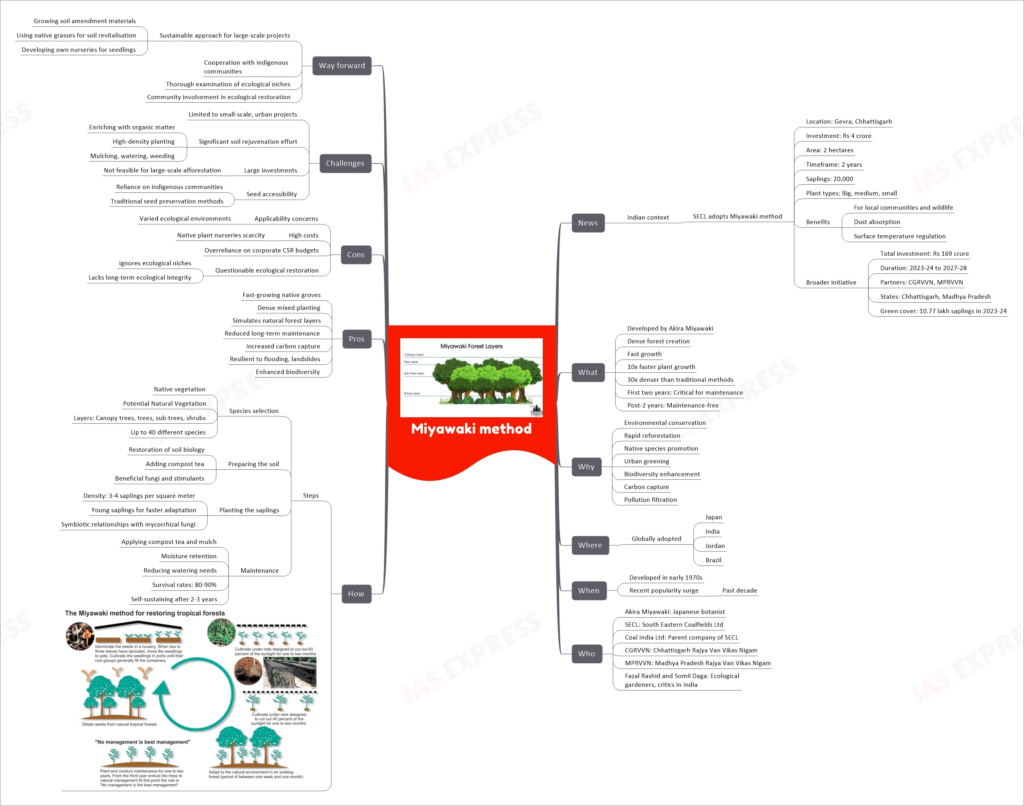The Miyawaki Method: A Revolution in Reforestation
The South Eastern Coalfields Ltd (SECL) has recently adopted the Miyawaki method to transform a 2-hectare area in Gevra, Chhattisgarh. This environmentally conscious initiative, with an investment of Rs 4 crore, involves planting 20,000 saplings of various plant types. The project aims to benefit local communities, wildlife, and the environment by absorbing dust, regulating surface temperatures, and contributing to a broader green initiative spanning Chhattisgarh and Madhya Pradesh. This broader effort, with a total investment of Rs 169 crore, is set to plant a staggering 10.77 lakh saplings from 2023-24 to 2027-28, in collaboration with CGRVVN and MPRVVN.
This topic of “The Miyawaki Method: A Revolution in Reforestation” is important from the perspective of the UPSC IAS Examination, which falls under General Studies Portion.
What is the Miyawaki Method?
Developed by Japanese botanist Akira Miyawaki in the early 1970s, the Miyawaki method is a pioneering approach to create dense forests with rapid plant growth. It boasts several advantages over traditional reforestation methods, including 10 times faster plant growth and 30 times greater density. The method requires intensive maintenance during the first two years but becomes virtually maintenance-free thereafter.
Why Choose the Miyawaki Method?
The Miyawaki method has gained popularity worldwide due to its environmental conservation benefits. It promotes rapid reforestation with native species, contributes to urban greening, enhances biodiversity, captures carbon, and filters pollution.
Where is the Miyawaki Method Adopted?
The Miyawaki method has been adopted globally, including in Japan, India, Jordan, and Brazil, highlighting its versatility and effectiveness in various ecological settings.
When Did the Miyawaki Method Gain Popularity?
Although developed in the early 1970s, the Miyawaki method has witnessed a surge in popularity over the past decade as the world increasingly recognizes the importance of ecological restoration and sustainable afforestation.
Who are the Key Players?
Akira Miyawaki, the method’s creator, is a central figure in its adoption. In the Indian context, SECL (South Eastern Coalfields Ltd), a subsidiary of Coal India Ltd, has embraced this method. Ecological gardeners Fazal Rashid and Somil Daga have been vocal critics and proponents of the Miyawaki method in India.
How Does the Miyawaki Method Work?
The Miyawaki method involves several key steps:
- Species Selection: Native vegetation, Potential Natural Vegetation, and multiple layers of plant types, up to 40 different species, are carefully chosen.
- Preparing the Soil: Soil biology is restored, compost tea is added, and beneficial fungi and stimulants are employed.
- Planting the Saplings: Saplings are densely planted (3-4 per square meter), including young ones for faster adaptation and symbiotic relationships with mycorrhizal fungi.
- Maintenance: Compost tea and mulch are applied to retain moisture, reduce watering needs, and achieve survival rates of 80-90%. The system becomes self-sustaining after 2-3 years.
Pros and Cons of the Miyawaki Method
Pros:
- Fast-growing native groves
- Dense mixed planting resembling natural forest layers
- Reduced long-term maintenance
- Increased carbon capture
- Resilience to flooding and landslides
- Enhanced biodiversity
Cons:
- Applicability concerns in varied ecological environments
- High costs, particularly due to scarcity of native plant nurseries
- Overreliance on corporate CSR budgets
- Questionable ecological restoration, as it may ignore ecological niches and lack long-term ecological integrity
Challenges and the Way Forward
Challenges include limited applicability to small-scale, urban projects, significant soil rejuvenation efforts, high investments not feasible for large-scale afforestation, and reliance on indigenous communities for seed accessibility.
To address these challenges, a sustainable approach for large-scale projects should include growing soil amendment materials, using native grasses for soil revitalization, developing in-house nurseries for seedlings, and fostering cooperation with indigenous communities. A thorough examination of ecological niches and community involvement in ecological restoration will be key to the method’s success in the future.


